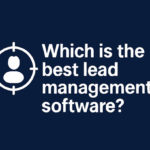In today’s competitive business landscape, simply generating leads is not enough. The real challenge lies in managing these leads effectively and scoring them accurately to identify which ones deserve immediate attention. Enter the dynamic duo: lead management and lead scoring—powerful strategies that empower marketing and sales teams to collaborate, streamline their efforts, and ultimately drive higher conversions.
Whether you’re a budding startup or a seasoned enterprise, lead management and scoring strategies can supercharge your pipeline by qualifying prospects and personalizing engagement. This in-depth guide will walk you through everything you need to build a data-driven lead strategy that delivers measurable results.
Table of Contents
What Is Lead Management?
Lead management is the structured process of acquiring, tracking, qualifying, distributing, nurturing, and converting leads. It ensures no opportunity is missed by providing visibility into the lead journey from the first touchpoint to conversion.
Core activities include:
-
Lead Capture: Collecting data from forms, chatbots, emails, or third-party imports.
-
Lead Tracking: Monitoring actions like page visits, downloads, or webinar signups.
-
Lead Distribution: Assigning leads to sales teams using intelligent routing rules.
-
Lead Nurturing: Delivering relevant and timely follow-ups based on behavior.
-
Lead Conversion: Closing the deal and ensuring post-sale engagement.
A robust lead management strategy reduces friction in the pipeline and aligns teams for better performance.
The Importance of Lead Management
Strong lead management practices are fundamental for scaling customer acquisition without losing efficiency. Let’s examine why:
-
🔥 Boosts Sales Productivity: Sales reps focus on qualified leads, not cold contacts.
-
💸 Reduces Acquisition Costs: Better targeting leads to improved return on investment (ROI).
-
⏱️ Accelerates Sales Cycles: Leads get what they need faster, shortening the journey.
-
🤝 Aligns Sales & Marketing: Everyone works from the same playbook.
-
📈 Increases Conversions: No missed follow-ups = more closed deals.
According to Forrester Research, companies with strong lead management systems generate 50% more sales-ready leads at 33% lower cost.
What Is Lead Scoring?
Lead scoring is the process of assigning value to leads based on their demographics, firmographics, and behavioral data. The goal is to determine how ready a lead is to engage with your sales team.
Lead scoring considers:
-
🎯 Demographics: Age, job role, location, etc.
-
🏢 Firmographics: Company size, revenue, and industry.
-
🧠 Behavioral Signals: Website visits, email engagement, content downloads.
-
📞 Engagement: Responses to outreach, demo requests, etc.
High-scoring leads are tagged as sales-qualified (SQLs) and passed to sales for immediate engagement, while lower scores may enter a nurturing funnel.
This technique prevents wasted effort and ensures lead management resources are applied where they matter most.
How Lead Management and Lead Scoring Work Together
Lead management and scoring strategies form a powerful tandem:
-
Lead management keeps the process structured and transparent.
-
Lead scoring tells you which leads deserve action now.
When combined, they offer a predictive system for sales and marketing teams to work smarter, not harder. Scoring acts as the qualification engine, while management acts as the execution framework.
Benefits of this integration:
-
🔍 Improved pipeline visibility
-
🔗 Seamless marketing-to-sales handoff
-
🎯 Higher conversion rates
-
🧭 Prioritized follow-up based on intent
Lead Lifecycle: From Capture to Conversion
Understanding the lead lifecycle is key to implementing lead management and scoring strategies effectively.
Typical stages:
-
Lead Capture – A visitor fills out a form or subscribes to a newsletter.
-
Lead Enrichment – Tools like Clearbit or ZoomInfo gather additional data.
-
Lead Scoring – The lead is scored using both explicit and behavioral metrics.
-
Lead Routing – Qualified leads are assigned to the right sales rep.
-
Lead Nurturing – Tailored email drips or personal follow-ups engage the lead further.
-
Sales Handoff – If qualified, the lead becomes an SQL and enters the sales pipeline.
-
Conversion – The lead becomes a paying customer.
CRMs like HubSpot or Salesforce can automate many of these steps.
Types of Leads You Should Know
To design an effective lead scoring system, you must understand lead types:
-
MQL (Marketing Qualified Lead): Engaged with your marketing but not ready for sales.
-
SQL (Sales Qualified Lead): Passed from marketing, ready for direct outreach.
-
PQL (Product Qualified Lead): Has used or tested your product (common in SaaS).
-
Service Qualified Lead: Existing customers showing interest in upgrades.
Each type requires different nurturing and scoring tactics to move forward in the funnel.
How to Set Up an Effective Lead Scoring System
Building a lead scoring model that works starts with knowing your audience and defining success.
Step-by-Step Guide:
1. Define Your Ideal Customer Profile (ICP)
Analyze your top customers and identify shared traits:
-
Industry
-
Company size
-
Job title
-
Use case
-
Pain points
2. Create Your Scoring Matrix
Split scores into:
-
Explicit (demographic/firmographic): e.g., +10 for CMO title
-
Implicit (behavioral): e.g., +5 for pricing page visits
Negative scoring is equally important. For instance:
-
-10 for unsubscribing from email
-
-15 for invalid phone number
3. Set Your Scoring Thresholds
Decide what score qualifies a lead as MQL, SQL, or Disqualified.
Example:
-
MQL = 40+
-
SQL = 80+
4. Use Automation Tools
Platforms like Marketo, Pardot, or ActiveCampaign simplify score tracking and updates.
5. Analyze, Test, Refine
Scoring isn’t set-it-and-forget-it. Run periodic checks and consult with sales teams to improve accuracy.
Best Tools for Lead Management and Scoring
Implementing your lead management and scoring strategies becomes easier with the right tech stack.
🔧 Top CRM Platforms
-
HubSpot CRM – Excellent for small to midsize businesses.
-
Salesforce – Enterprise-level with robust customization.
-
Zoho CRM – Cost-effective and scalable.
🔍 Best Scoring & Automation Tools
-
Pardot – Salesforce’s marketing automation with scoring baked in.
-
Marketo – For advanced marketers.
-
LeadSquared – Simple lead capture and scoring.
-
ActiveCampaign – Great for email-driven businesses.
Integrate these tools with your CRM to gain real-time lead intelligence.
Common Mistakes to Avoid
Even the best lead management and scoring strategies can fail if you fall into these traps:
-
❌ Overcomplicating your scoring model
-
❌ Failing to use negative scores
-
❌ Using outdated or incomplete data
-
❌ Not aligning with sales on scoring logic
-
❌ Ignoring behavior signals post-conversion
Avoid these errors to keep your system effective and trustworthy.
Future Trends in Lead Management and Scoring
The future of lead management and scoring is being shaped by AI and predictive analytics.
Upcoming trends include:
-
🤖 AI-Powered Predictive Scoring – Tools like 6sense forecast conversion probability.
-
🧠 Intent-Based Marketing – Using third-party intent data to spot buying signals early.
-
🗣️ Conversational AI – Chatbots that qualify leads in real time.
-
📡 Omni-channel Tracking – Track interactions across email, ads, social, and websites.
Companies embracing these trends are seeing faster lead conversions and better ROI.
Conclusion
A well-executed lead management and scoring strategy is no longer a luxury—it’s a competitive necessity. It enables your team to:
-
📈 Focus on high-quality leads
-
🤝 Align marketing and sales
-
🚀 Accelerate conversions
-
💰 Maximize ROI
By implementing the strategies and tools discussed here, you’ll be better equipped to build a predictable, scalable revenue engine.














